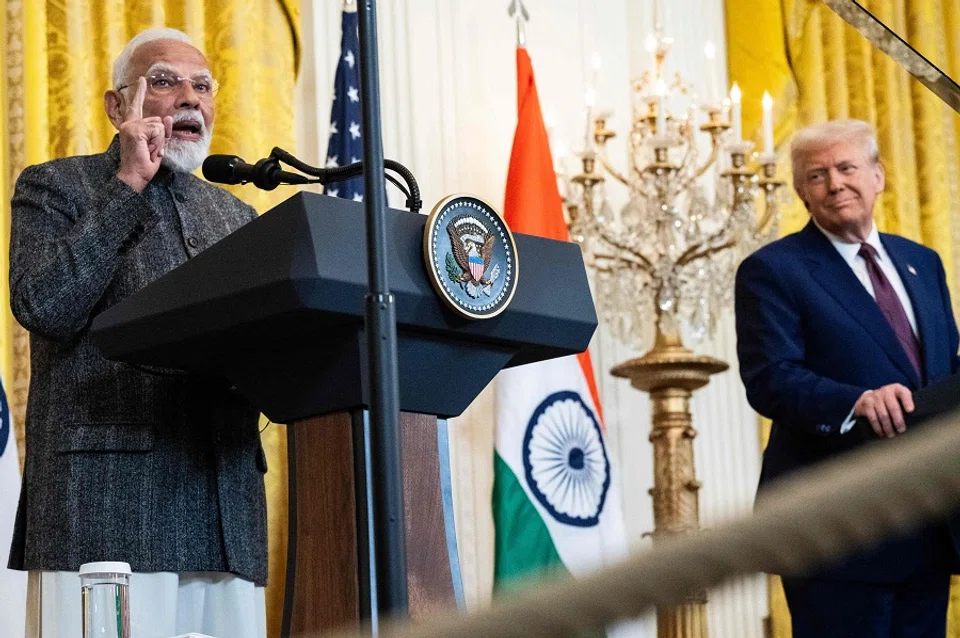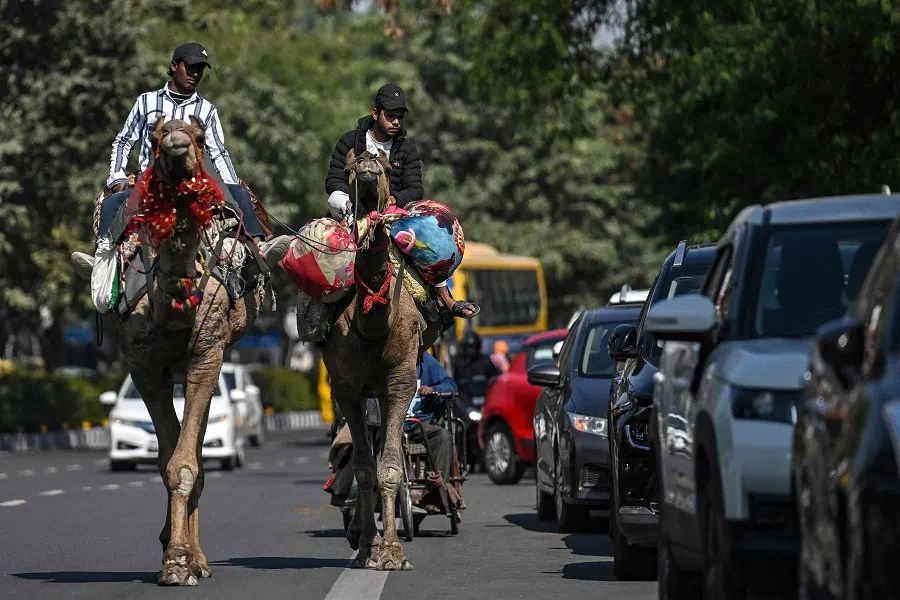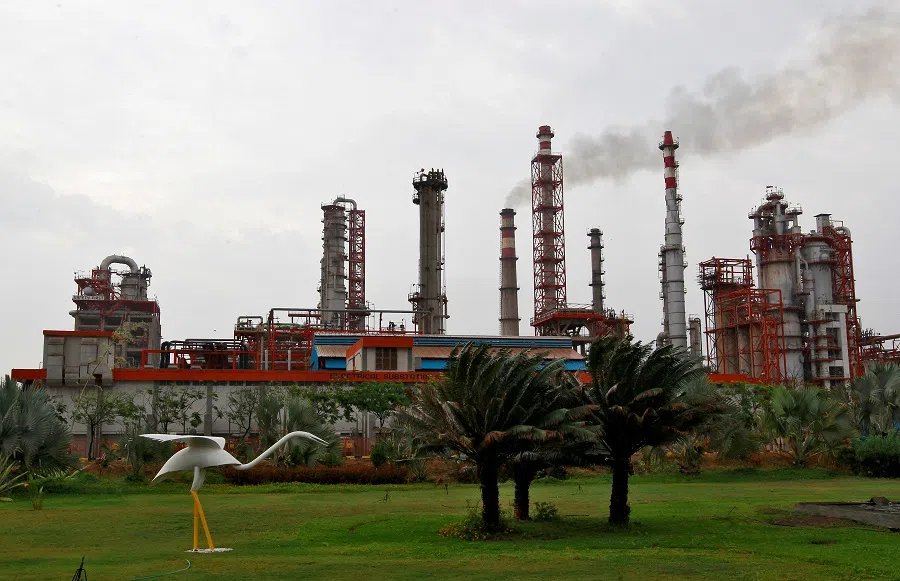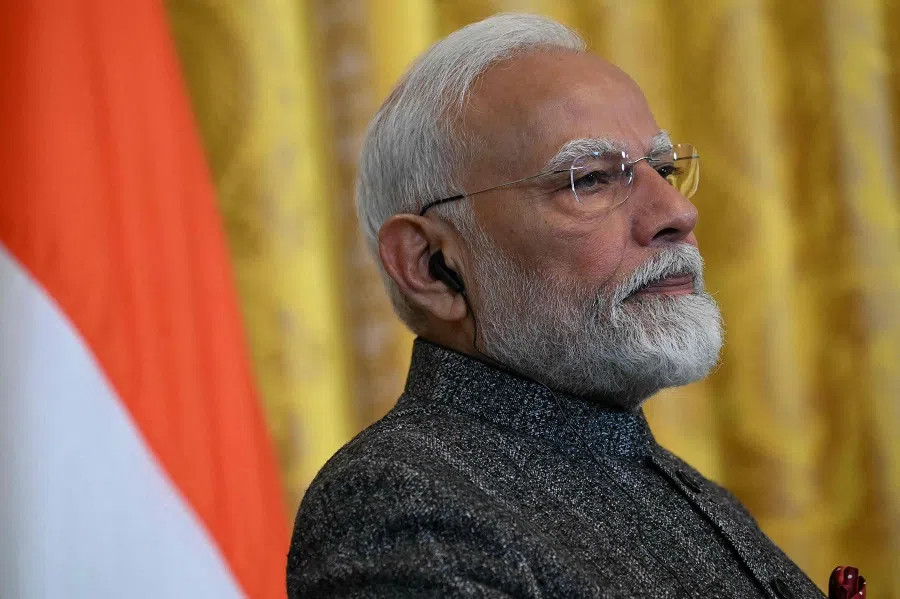US-India partnership forged in deals: A response to China’s rise?
While India and the US reaffirmed a good relationship during Indian Prime Minister Narendra Modi’s state visit to the US, their alignment or prospects for a more common approach on China is still uncertain, says Indian academic Rishi Gupta.

“Mr Prime Minister, you are great” — a message President Donald Trump signed on the coffee table book Our Journey Together that he gifted Indian Prime Minister Narendra Modi during the latter’s first state visit to the US on 13 February. The message was a nod to the “bromance” the two leaders shared during President Trump’s first tenure in office.
Modi was the second non-treaty ally of the US to be hosted by Trump within three weeks of taking the oath of office for the second time. This was also Modi’s second visit to the US in less than six months. Modi’s state visit was marked by optimism, a quest to maintain the momentum in the India-US Global Strategic Partnership, which grew multifold in several sectors during the Biden administration.
For decades, India and the US have found common ground in their strategic challenge — China. However, the lexicon in the US appears to be shifting, raising critical questions — where does Beijing now figure into the India-US equation, and how do the Trump-Modi summit outcomes redefine the India-US-China triangle?
India a key partner in a transactional presidency
By now, the foremost global power centres, including Europe and Asia, have come clear that the Trump presidency will be transactional and reciprocal regarding trade and everything wherever the American interests lie. Along these lines, India made it to the priority list of Trump’s first few important guests, reflecting upon the growing importance of India on many fronts, especially as one of the biggest markets for American defence and strategic technology partnerships.
This includes advanced military equipment, surveillance systems and missile defence systems, strengthening bilateral ties under the broader Indo-Pacific strategy. At the same time, India has also emerged as a leading defence exported to the US. In 2024, the US topped India’s defence exports, exhibiting Delhi’s push for manufacturing and exporting its indigenous defence products to more than 100 countries.
... India has been demanding tech transfer from the US in the defence sector, which witnessed some echo during the summit.

The Joint Statement released at the Trump-Modi Summit had an expansive list of outcomes, beginning with the re-affirmation of the India-US Comprehensive Global Partnership — a partnership whose vision and principles were laid during President Trump’s maiden state visit to India in February 2020 — focusing on trade, defence, technology, space, the Indo-Pacific, Partnership for the Global Leadership, etc.
Against this backdrop, a new initiative, the US-India COMPACT (Catalysing Opportunities for Military Partnership, Accelerated Commerce & Technology) for the 21st Century, was launched, which is aimed at “transformative change across key pillars of cooperation.” This is an overarching initiative with much bandwidth allotted to defence, technology and trade — the most prominent areas during the summit.
Defence deals and regional responses
On the defence front, the two sides unveiled a new ten-year Framework for the US-India Major Defence Partnership in the 21st Century. This framework aligns with the India-US Defence Cooperation, specifically focusing on co-development and co-production. There is already an existing Indian inventory with US-origin defence products, including C-130J Super Hercules, C-17 Globemaster, etc. However, the other key highlights were agreements on purchasing and manufacturing Stryker infantry combat vehicles, Javelin missiles and India readying to acquire additional P-81 maritime reconnaissance aircraft.
At the press meet, President Trump also mentioned, “We’re also paving the way to provide India with the F-35 stealth fighters ultimately.” However, this was absent from the joint communique, primarily due to the high costs and operational challenges attached to F-35 fighter jets. The Defence experts in India see the push for the F-35 as a slow-moving deal as Delhi has more concerns than optimism about it. Meanwhile, India has been demanding tech transfer from the US in the defence sector, which witnessed some echo during the summit.
Meanwhile, the potential addition of advanced military capabilities to Delhi’s defence inventory has elicited a strong response from India’s arch-rival, Pakistan, which has voiced deep concerns over the development. Pakistan has particularly objected to the planned transfer of advanced military technologies to India, which it sees as a threat to itself.
Interestingly, China also reacted to the defence agreements during the Modi-Trump summit. The spokesperson for the Chinese foreign ministry, in response to US military sales to India, including F-35 fighter jets, stated that “the Asia-Pacific is a stellar example of peace and development, not an arena for geopolitical games. Ganging up to form exclusive groupings and engaging in bloc politics and confrontation will not bring about security and will by no means keep the Asia-Pacific and the whole world peaceful and stable.”
However, Delhi must have expected such responses from Islamabad and Beijing. After the border confrontation with China at the Line of Actual Control (LAC) in June 2020, India has been upgrading and expanding its defence inventory, including the acquisition of French Rafale fighter jets. It recognises that strategic preparedness is essential to safeguard its sovereignty and maintain regional stability in the face of emerging threats.
With the new energy deal in place aimed at establishing the US “as the leading supplier of crude oil and petroleum products and liquified natural gas in India”, and the potential of US-origin defence inventory expanding, seeing a trade balance may be a possibility in the near future...
Mission 500 — an ambitious trade target
On the trade front, India and the US have set an ambitious target of US$ 500 billion in bilateral trade annually under the “Mission 500” by 2030. In 2024, the bilateral trade between the two was estimated at USD 129 billion, with US exports accounting for USD 41.8 billion and Indian exports at USD 87.4 billion.

Meanwhile, in a rare occurrence, India enjoys a trade surplus over the US, which has undoubtedly caught President Trump’s attention. With the new energy deal in place aimed at establishing the US “as the leading supplier of crude oil and petroleum products and liquified natural gas in India”, and the potential of US-origin defence inventory expanding, seeing a trade balance may be a possibility in the near future to “promote growth that ensures fairness”.
The two countries also have plans to negotiate the first segment of a multi-sector Bilateral Trade Agreement (BTA) by the fall of 2025 — some of it had been tried and pushed during Trump 1.0, and the possibilities of BTA getting a certain shape remain high. On all practical fronts, a negotiated BTA could benefit both nations by reducing trade barriers, enhancing market access, and fostering investment opportunities. While India could gain from greater access to US technology and investments in key sectors, the US would likely benefit from increased exports, particularly in energy, defence and agriculture, thereby reducing the current trade imbalance.
The announcement to advance plans for building US-designed nuclear reactors in India, facilitated by large-scale localisation and potential technology transfer, marks a significant milestone.
Energy deals
Among their other collaborations, the energy deals inked are worth mentioning as they have a strategic meaning, especially since India’s growing manufacturing needs necessitate Delhi to find reliable sources of energy, and that is where agreement on the announcement of fully realising their commitment to the “US-India 123 Civil Nuclear Agreement by “moving forward with plans to work together to build US-designed nuclear reactors in India through large scale localisation and possible technology transfer” makes a huge difference.
The announcement to advance plans for building US-designed nuclear reactors in India, facilitated by large-scale localisation and potential technology transfer, marks a significant milestone. To support this, India has pledged to introduce reforms to the Nuclear Atomic Energy Act and the Civil Liability for Nuclear Damage Act, a move that the US views as a key enabler for expanding nuclear reactor sales and deepening bilateral cooperation in the energy sector. They also agreed to continue cooperation in the Quad and infuse life into the India-Middle East Europe Corridor (IMEC) — which both India and the US continue to emphasise as a strategic gateway for peace and prosperity across these regions.
Tariffs and immigration
President Trump minces no words when it comes to tariffs — a word he finds most “beautiful” after God, religion and love. While for many, Trump may have used tariffs as a strategic weapon against countries like China, Canada and Colombia, he wants India too to be fair on this front.
During the joint press conference with his “friend” Modi, Trump was categorical in raising the tariff issue, which he called “unfair”. Further adding to this, Trump said, “As a signal of good faith, Prime Minister Modi recently announced the reductions to India’s unfair, very strong tariffs that limit US access into the Indian market very strongly. And really, it’s a big problem, I must say. India imposes a 30 to 40 to 60 and even 7% tariff on so many of the goods and, in some cases, far more than that. As an example, a 70% tariff on US cars going into India, which makes it pretty much impossible to sell those cars.”
Such a response from President Trump was already making rounds in the Indian media before a meeting at the White House. However, Modi seemed to have prepared better and agreed to all fair means in negotiating tariffs and striking a balance.

On illegal immigration, India has been more than welcoming to US policies. As per Pew Research, Indian Americans constituted 4.8 million of the total US population in 2022, accounting for 20% of America’s Asian American population overall. While Indian Americans contribute across the sectors, most of them being in the science and tech industry, they are also making their presence felt in US politics with some prominent names like Kash Patel and Tulsi Gabbard appointed to top positions in the Trump 2.0.
However, the challenge is all about illegal immigrants, which Prime Minister Modi has readily agreed to resolve, adding, “We are of the opinion that anybody who enters another country illegally, they — they have absolutely no right to be in that country. And as far as India and the US are concerned, we have always been of the same opinion, and that is that any verified Indian who is in the US illegally, we are fully prepared to take them back to India.”
Approximately 500 illegal immigrants have been deported to India on different dedicated flights, reflecting India’s commitment. Clearly, India is not interested in keeping the entire relationship hostage to issues whose resolve can be found amicably.
There is a clear indication that in line with his administration’s inward-looking approach, Trump does not wish to unite the democratic world against China; after all, Beijing continues to be the biggest trading partner of the US...
China-India-US nexus
President Trump, on being asked, “How do you see this relationship between India and the United States to counter China?” answered, “We are going to have a very good relationship with China. I got along with President Xi very well until Covid. That was a bridge too far. But until then, I got along with President Xi very, very well. We were very close, as leaders go. I don’t want to be naive, but as leaders go, I think we were very close.”
Also, highlighting China’s role in global affairs, he remarked, “China is a very important player in the world. I think they can help us get this war over with Ukraine and Russia.” Meanwhile, regarding India, Trump added, “I do see the skirmishes on the border, which are quite vicious, and I guess they continue to go on. If I could be of help, I’d love to help because that should be stopped. That’s been going on for a long time, and it’s quite violent. It’s quite violent.”
There is a clear indication that in line with his administration’s inward-looking approach, Trump does not wish to unite the democratic world against China; after all, Beijing continues to be the biggest trading partner of the US, and with his “The Art of the Deal” approach, Trump intends to make no enemies — not at least publicly.
Meanwhile, on his proposal to be of help in the border row between India and China, neither of the parties would want an external intervention. In the last 70 years of India’s modern diplomacy, India has strongly resisted any third-party role in its disputes with China or Pakistan. That said, the Indo-Pacific and Quad unity certainly have unsaid elements of countering China’s expansionist role in the South China Sea, safeguarding global supply chains, and “enhanced logistics and intelligence sharing, as well as arrangements to improve force mobility for joint humanitarian and disaster relief operations along with other exchanges and security cooperation engagements”.
These efforts strengthen strategic deterrence against coercive tactics and ensure regional stability by fostering collaboration among like-minded nations. Furthermore, improved force mobility and intelligence-sharing help preempt security threats, facilitate rapid responses to crises, and reinforce the rules-based international order.
Overall, the Modi-Trump summit highlights significant diplomatic progress in launching new initiatives and addressing key challenges. Many of these agreements will be clearer when Modi and Trump meet again at the Quad Summit in Delhi this September.





